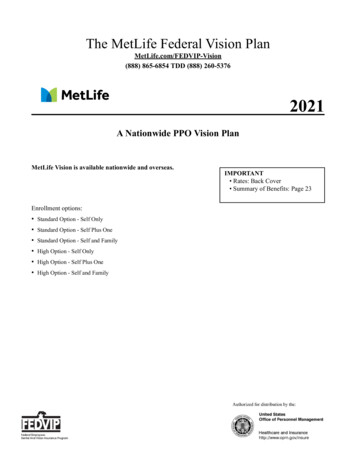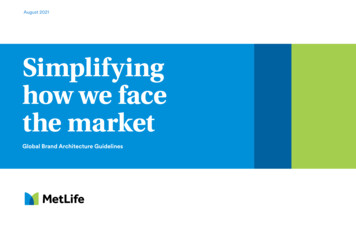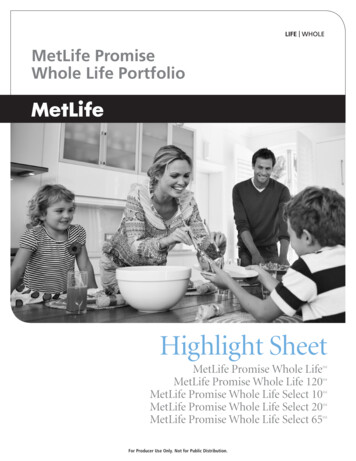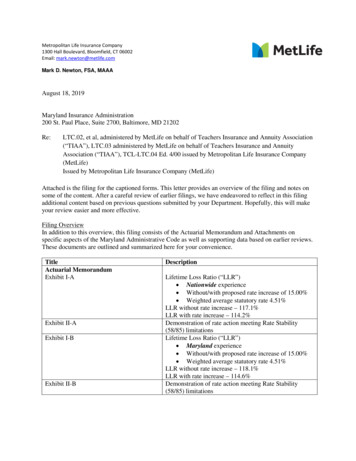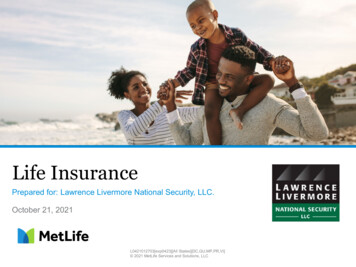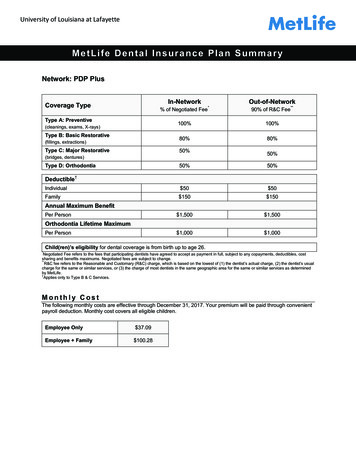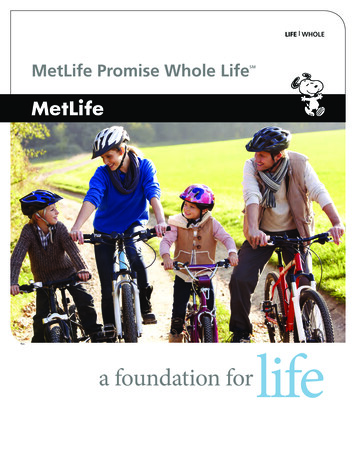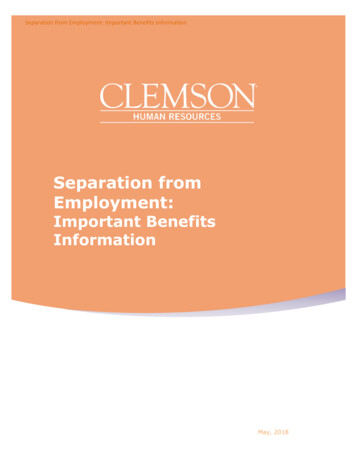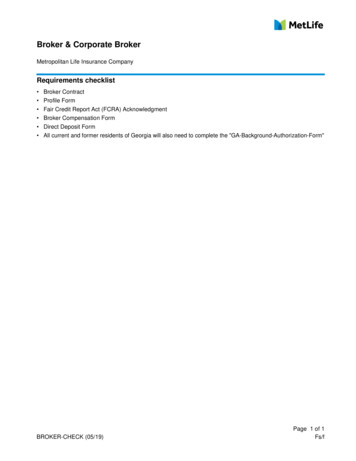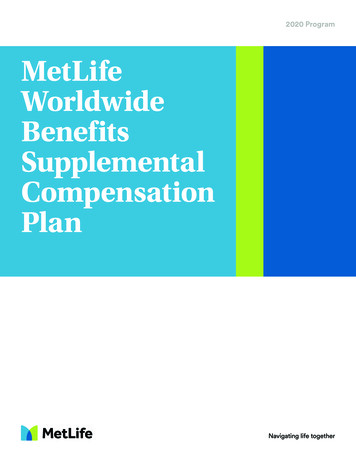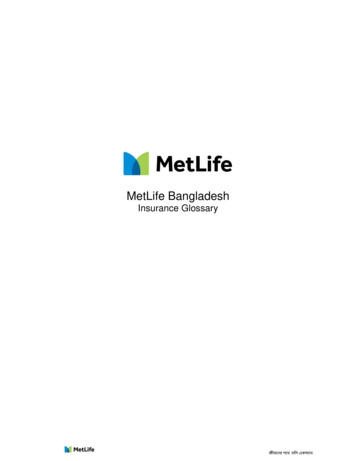
Transcription
MetLife BangladeshInsurance Glossary
1. Account Value (AV): is the balance of the Account under Universal Life Insurancepolicy. Upon maturity of such type of Life insurance policy, Account Value is providedto the policy owner as maturity value. In case of Death, Face Amount or AccountValue, whichever is higher is paid to the beneficiary.2. Automatic Non-Forfeiture Option: is the automatic option, becomes effective afterthe grace period once premium is unpaid to the policy. Automatic Premium Loan(APL) could be Automatic Non-Forfeiture Option of the policy. APL becomeseffective to the premium unpaid policy once policy acquires Cash Value. To repayAPL, a policy owner needs to repay unpaid premium along with interest on unpaidpremium.3. Age Limits: required minimum and maximum ages below and above which theinsurance company will not accept applications or may not renew policies.4. Agent /Financial Associate: an individual who sells, services, or negotiatesinsurance policies either on behalf of a company or independently.5. Assignment: It means legal transference. It is a method of authorizing anotherperson (a lender) as the principal beneficiary of a death benefit to use as collateralfor a loan. If the borrower (policy holder) is incapable to pay, the lender can cash inthe life insurance policy of the borrower and recover what is owed.6. Basic Cash Value: It is end of policy year wise cash value table provided by thecompany at the time of policy issuance. Company may provide guarantee on theBasic Cash Value in such a way that policy owner will be entitled to get Basic CashValue at the time policy matures or at any time surrendering the policy before policymatures. Before policy matures while surrendering, the policy owner is eligible to getyear wise basic cash value and cash value of Reversionary Bonus. For ordinary lifepolicy, Basic Cash value grows after first two years of the policy.7. Basic Policy: This is the main insurance policy purchased by the customer.Generally, basic policy provides death coverage during the term of the policy andprovides Maturity Value at the end of the term of the policy.8. Beneficiary: The person of party designed by the policy owner as being the recipientof benefits in the event of death of the Insured.9. Cash Surrender: It is the voluntary option of the policy owner to discontinue thepolicy before policy matures. Upon surrendering the policy, policy owner will beeligible to get Net Cash surrender Value, if any, of the policy. Cash surrender is oneof the non-forfeiture options of the policy.10. Critical Illnesses: These are the conditions when one or more vital organ(s) (brain,heart, Kidney, liver, and multi organ failure) of the body are affected and the patientneeds urgent medical support for recovery. Major critical illnesses are: Stroke,Cancer, First Heart Attack, Coronary Artery By-pass Surgery, Benign Brain Tumor,Kidney failure etc.
11. Coverage: The range of protection provided under a contract of insurance; any ofnumerous risks covered by a policy.12. Date of Issue: Date when an insurance company issues a policy.13. Days of Grace /Grace Period: It is a provision in most loans and insurance policies.It provides the policy holder with extra days, after the due date, to make thepayment of the premiums without any late fee, these extra days period is known asDays of Grace.14. Death Benefit: It is the amount of benefit on a life insurance policy or pension thatwill be paid to the beneficiary in the event of the death of the insured person.15. Effective Date/Policy Date: Date at which an insurance policy goes into force.16. Elective Non-Forfeiture Option: It is the option chosen by the policy owner at thetime of policy application. Elective Non-forfeiture options could be a) Cash Surrenderb) Reduced Paid up Insurance c) Extended Term Insurance.17. Endowment product: An ordinary individual life insurance product that provides theinsured party with various guaranteed benefits if it survives specific maturity dates orperiods stated in the policy. Upon the death of the insured party within the coverageperiod, a designated beneficiary receives the face value of the policy.18. Extended Terms Insurance (ETI): Converting any Par-Insurance policy to Non-Parinsurance policy using Cash value of the par-policy. After conversion, a policy owneronly enjoys Life coverage without any maturity value up to the end of the term of thepolicy.19. Face Amount/Coverage Amount: It is the amount of insurance that policy providesas death benefit or from which Death benefit is determined.20. Free Look Up Period: It is the period during which time the insured can cancel thepolicy by sending written notice to the company.21. Grace Period: is the period starts from premium due date, granted by the company,during which policy owner is eligible to pay due premium without any interest.Generally, grace period is 31 days from premium due date.22. Health and protection/Accident and Health: These comprise health and personalaccident insurance products, which provide morbidity or sickness benefits andinclude health, disability, critical illness and accident coverage. Health and protectionproducts are sold both as standalone policies and as riders that can be attached tolife insurance products. Health and Protection riders are presented together withordinary individual life insurance products for purposes of disclosure of financialinformation.23. In-force: An insurance policy or contract reflected on records that has not expired,matured or otherwise been surrendered or terminated.
24. Insurability: All conditions concerning individuals that affect their health,susceptibility to injury and life expectancy; it is basically an individual's risk profile.25. Insurable Interest: It is a basic prerequisite for any insurance body to issue a policy.Entities which are not subject to financial loss from an event do not have aninsurable interest and they cannot receive an insurance policy to cover that event.26. Investment Earning/Crediting Interest Rate: It is the earning rate credited to theAccount Value of the policy owner’s Universal Life insurance Investment Account.27. Lapse: It is the discontinuation of the insurance coverage, after grace period of thepolicy while premium remains unpaid and the policy does not acquire any basic cashvalue. Lapses policy does not have any value; however that can be re-instated withinfive years (in some policies within three years) by providing outstanding premiumand interest on outstanding premium.28. Maturity Value: This is the amount which is received after successfully completingthe term of insurance policy, if there is no claim. Generally, Maturity Value consists ofBasic Face Amount of the basic policy along with Insurance Company declaredPolicy Bonus (es), if any.29. Modal Premium: This is the premium payment mode of annual, semi-annual,quarterly and monthly of policy. Semi-annual premium is 52% of annual premiumwhile quarterly and monthly modal premiums are 27% and 9% respectively, ofannual premium.30. Net Cash Surrender Value/Surrender Value: This is the surrender value less anyindebtedness with the company. Policy owner gets Net Cash Surrender Value at thetime of surrendering the policy. For Ordinary Life Policy, surrender value is the basiccash value and cash value of Reversionary Bonus, if any.31. Non-Participating (Non-PAR) Policy: This is the life insurance policy which doesnot participate in the profit or surplus of the company. Generally, Term insurancepolicy and supplementary contract are non-par policy.32. Participating (PAR) Policy: is the life insurance policy which participate in the profitor surplus of the company. Profit or surplus is distributed annually as ReversionaryBonus or Terminal Bonus. Generally, Ordinary Life policies are PAR policy. It is notcertain that company will declare Reversionary Bonus and Terminal Bonus in eachyear of the policy. Declaration of Bonus depends upon market interest rates andother external factors such as regulatory capital requirements etc.33. Policy Bonus: is the amount declared by the Company on yearly basis. This is theadditional amount of Policy Basic Face Amount, and can be received at the end ofthe Policy Term, if insured is alive or can be provided to beneficiary, if insured persondies. Depending on the term of the policy there can be two types of the Bonus (es),Reversionary Bonus (RB) and Terminal Bonus (TB) (Capital Growth Bonus). RB canbe declared with any term while TB is generally declared with the policies havinghigher policy term such as 16 years and above. It is important to keep in mind thatpolicy bonus (es) are not guaranteed and depend upon company’s investment return
and other external factors, including market interest rates and other regulatory capitalrequirements.34. Policy Exclusions: are the conditions which are not covered in the insurance policyor for which no insurance benefit will be provided.35. Policy Term/Premium Payment Phase of the Insurance Policy: is the duration forwhich insurance is purchased and during which insured person enjoys coveragethrough paying premium. For example 5 years term, 12 years term, 18 years terminsurance etc. Life insurance policies having Cash Value, provides Maturity Valueafter the end of the Policy Term/Premium Payment Phase.36. Pre-existing condition: is a condition that was diagnosed, treated or for which aphysician was consulted at any time prior to the insurance takes effect, whether ornot declared in the insurance application.37. Premium: is the amount payable by the owner to the company in respect of thebasic policy and the Supplementary Contract.38. Reduced Paid Up (RPU) Insurance: is converting any Par-Insurance policy to NonPar insurance policy using Cash value of the par-policy. After conversion, RPUamount is paid on the survival to the end of the premium payment term or uponearlier death of the policy owner/insured.39. Regular premium product: A life insurance product with regular periodic premiumpayments.40. Reinstatement: is the reinforcement of the coverage of the policy once policy islapsed. Once reinstated, policy owner needs to pay default premium and to produceevidence of insurability like good health declaration or medical health profile.41. Rider: This is a supplemental plan that can be attached to a basic insurance policy,with payment of additional premium.42. Single premiums: single premium policies of insurance are those that require only asingle lump sum payment from the policyholder.43. Supplementary Contract: is the additional insurance policy with is packaged or soldwith basic policy. Supplementary Contract is also called Rider. SupplementaryContract/Rider provides pure insurance protection during the term of the policy anddoes not provide any maturity value or return at the end of the term.44. Surrender charge or surrender fee the fee charged to a policyholder when a lifeinsurance policy or annuity contract is surrendered for its cash surrender value priorto the end of the surrender charge period.45. Takaful: This is a type of Islamic insurance, where participants/policyholderscontribute money into a pool system in order to guarantee each other against loss ordamage. Takaful insurance is based on Sharia, Islamic religious law, and explains
how it is the responsibility of individuals to cooperate and protect each other.46. Universal Life Insurance: is an investment type insurance policy where aninvestment account is created and where Net premiums and Investment Earningsare credited and from where monthly deductions is made. Monthly deductions couldbe: premium charge, monthly account administration charge, and cost of insurancefor the life insurance coverage.47. Waiting Period: is the waiting time starts from policy effective date or lastreinstatement date, whichever is later, to coverage commencement date duringwhich time policy owner is not eligible to get any insurance coverage. Insurancecompany imposes waiting period condition to reduce anti-selection or to identify preexisting condition before effective any insurance coverage. Insurance company mayimpose 90 days or 180 days waiting period depending on the features of theinsurance benefits. Generally, critical illness insurance policy has waiting period.
MetLife Bangladesh Insurance Glossary . 1. Account Value (AV): is the balance of the Account under Universal Life Insurance policy. Upon maturity of such type of Life insurance policy, Account Value is provided . After conversion, a policy owner only enjoys Life coverage without any maturity value up to the end of the term of the policy.

